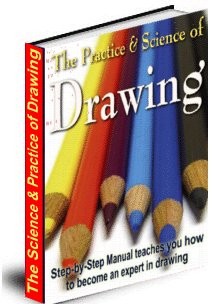 License Type: Resell Rights
License Type: Resell Rights  File Size: 8,050 KB
File Size: 8,050 KB File Type: ZIP
File Type: ZIP
 SKU: 17996
SKU: 17996  Shipping: Online Download
Shipping: Online Download
Ebook Sample Content Preview:
Most of the earliest forms of drawing known to us in history, like those of the child we were discussing in the last chapter, are largely in the nature of outline drawings. This is a remarkable fact considering the somewhat remote relation lines have to the complete phenomena of vision. Outlines can only be said to exist in appearances as the boundaries of masses. But even here a line seems a poor thing from the visual point of view; as the boundaries are not always clearly defined, but are continually merging into the surrounding mass and losing themselves to be caught up again later on and defined once more. Its relationship with visual appearances is not sufficient to just ify the inst inct for line drawing. It comes, I think, as has already been said, from the sense of touch. When an object is felt there is no merging in the surrounding mass, but a firm definit ion of its boundary, which the mind instinctively conceives as a line.
There is a more direct appeal to the imagination in line drawing than in possibly anyt hing else in pictorial art. The emotional stimulus given by fine design is due largely to line work. The power a line possesses of inst inct ively directing the eye along its course is of the utmost value also, enabling the artist to concentrate the attention of the beholder where he wishes. Then there is a harmonic sense in lines and their relat ionships, a music o f line that is found at the basis o f all good art. But this subject will be treated later on when talking of line rhythm.
Most artists whose work makes a large appeal to the imagination are strong on the value of line. Blake, whose visual knowledge was such a negligible quantity, but whose mental perceptions were so magnificent, was always insist ing on its value. And his designs are splendid examples of its powerful appeal to the imagination.
On this basis of line drawing the development of art proceeded. The early Egyptian wall paint ings were outlines t inted, and the earliest wall sculpture was an incised outline. After these incised lines some man of genius thought of cutting away the surface of the wall between the outlines and modeling it in low relief. The appearance of this may have suggested to the man painting his outline on the wall the idea of shading between his outlines.
At any rate the next development was the introduction o f a little shading to relieve the flatness of the line-work and suggest modeling. And this was as far as things had gone in the direction of the representation of form, unt il well on in the Italian Renaissance. Botticelli used nothing else than an outline light ly shaded to indicate form. Light and shade were not seriously perceived until Leonardo da Vinci. And a wonderful discovery it was thought to be, and was, indeed, although it seems difficult to understand where men’s eyes had been for so long with the phenomena of light and shade before them all the t ime. But this is only another proof of what cannot be too often insisted on, namely that the eye only sees what it is on the look-out for, and it may even be there are things just as wonderful yet to be discovered in vision.
But it was still the touch associat ion of an object that was the dominant one; it was within the outline demanded by this sense that the light and shade were to be introduced as something as it were put on the object. It was the “solids in space” idea that art was still appealing to.
“The first object of a painter is to make a simple flat surface appear like a relievo, and some of its parts detached from the ground; he who excels all others in that part of the art deserves the greatest praise,”[1] wrote Leonardo da Vinci, and the insistence on this “standing out” qualit y, with its appeal to the touch sense as something great in art, sounds very strange in these days. But it must be remembered that the means of creating this illusion were new to all and greatly wondered at.
- File Size:8,050 KB
- License: Resell Rights
- Category:Ebooks
- Tags:2008 Ebooks Resale Rights








